#bangladesh history
Explore tagged Tumblr posts
Video
youtube
The Bangladesh Liberation War
December 16, 1971 marked the end of the Bangladesh Liberation War, a short-lived conflict between India and Pakistan that established the People’s Republic of Bangladesh from the territory of the former province of East Pakistan.
CW: mention of sexual assault, genocide
4 notes
·
View notes
Text
youtube
#Bengali alphabet#Bangladeshi culture#Bengali script#Bangladesh history#Dhaka city#Bengali literature#Bangladesh cuisine#Bengali music#Bangladesh tourism#Bengali poetry#Bengali tradition#Bangladeshi art#Bangladesh economy#Bengali heritage#Bangladesh independence#Bangladeshi language#Bengali identity#Bengali folklore#Bangladesh politics#Bangladeshi society#Bengali customs#Bengali education#Bangladesh landmarks.#Bengali Alphabet#Bangla Script#Music#Entertainment#How-to#Gaming#Product reviews
1 note
·
View note
Text
youtube
View On WordPress
#1971#1971 War#Bangladesh History#Bangladesh Liberation War#Brave Warriors#Freedom Fighter Interview#Indian Army#Liberation Struggle#Mukti#muktijuddho#Pakistani Occupation#Youtube
0 notes
Text

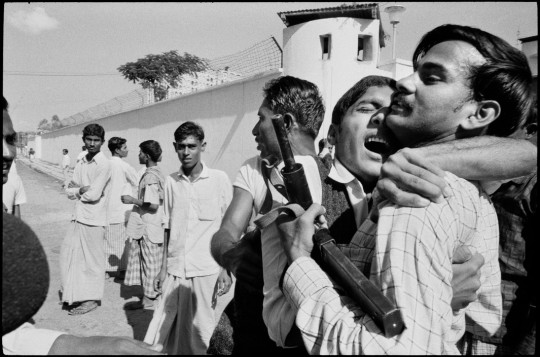
Abbas Attar's photographs of Dhaka on December 16, 1971: when the Pakistani Armed Forces finally surrendered to Mukti Bahini, ending the nine-month Liberation War and 1971 Bangladesh genocide and marking the official secession of East Pakistan to become the new state of Bangladesh. Bangladesh commemorates this day as Victory Day (বিজয় দিবস) to honour the martyrs who laid their lives down in the war.
#বিজয় দিবসের অনেক শুভেচ্ছা সকলকে#and one day we will celebrate a victory day for palestine#bangladesh#bangla tag#victory day#bangladesh liberation war#bengali#south asia#asia#history#historical photos#south asian history#ph#ots#abbas attar#iranian artist
546 notes
·
View notes
Text
that one line about ramy's bangla being rudimentary made me absolutely sob (i'm bengali) and i wanna talk about why
there's so much to it both contextually with ramy's character as well as historically. contextually because ramy is fluent in 6 languages, an insane number of languages for one person but none of which are his mother tongue. he's described as a performer, one who knows he can't blend in so instead he stands out as a means to escape as much of the racism as he can. he gets lost in it that he almost forgets who he is; this is reflected in his language ability too – he gets so lost in his linguistic academics he just barely remembers the native language of his home place that he adores.
and honestly, you can't even really blame ramy for it at all when it was induced. it's the british who saw urdu, arabic and persian as more valuable than bangla, it's the british that make ramy put on this act so he can literally stay alive. and when you know the historical relevancies between urdu and bangla, it hurts so much that ramy was forced to forget bangla
very brief history context: after the partition, where british india was split into india, pakistan and east pakistan (now bangladesh) bangla was seen as inferior to urdu due to its hindu connections. bengalis experienced so much shit because of this (and bengali muslims are still dealing with the internalised cultural racism today honestly). pakistanis tried to make the official language urdu, even though literally everyone in east pakistan were bengali and spoke bangla, so bengalis fought back against it. we still celebrate that day today (feb 21)
so to have ramy be in this position in the 1830s where urdu was seen as superior to bangla, especially when ramy is a bengali muslim, is just extremely accurate?? and maybe it's bc we don't have much western literature where we talk about this but it's just so nice to have it acknowledged
the bangla language movement didn't happen until around the 1950s, over a century after babel's timeline, but the seeds are always there. while i do think it comes with both this islamic superiority tendency a lot of asians have (arabs i'm looking at you) and britian's imperialistic racism, i just love how it all makes sense
#babel rf kuang#ramiz rafi mirza#i'm still learning a lot abt my own culture so don't ask me for a lot of information about this lol#yk when i found out ramy was bengali it set my world off its course and i knew i had to read this book even if no bangla was discussed#i knew i was gonna get attached to him and I DID!#he just means so much to me and while he made me sob multiple times i love what kuang did with his character#also if youre pakistani lol don't try to defend yourself#you don't get to after pakistanis massacred so many bengalis during the bangladesh liberation war#babel an arcane history#babel or the necessity of violence#also i love seeing south asian characters become fandom favourites i know most babel lovers love ramy IKTRRR
301 notes
·
View notes
Text
My own grandfather was a freedom fighter. But that is his achievement, in his lifetime. What right do I have to benefit from that? Even my dad wasn't born at that time.
My grandfather used to work as a police officer for a Nawab in a palace (which is now used as a museum) in Dhaka before the liberation war. My grandmother was the beloved handmaid of the wife of the Nawab. the 8 siblings of my mother were born and raised in the palace.
My grandfather was courageous. But he had 8 children and a wife. So during the massacre of 25th March, he left the city. My grandmother still says how she had to step over and on dead bodies, and walk to her village from the city all the way. How the river she had to cross through a boat was filled with fresh dead bodies, how vultures were eating the flesh by the morning of 26th March. She says that was the last she ever saw a vulture in her life. Vultures are nearly extinct in our country today. She is an 87-year-old woman, who often forgets her grandchildren's names. She can still clearly describe the horrors she saw.
After coming back, my grandfather started a grocery store. But his spirit to fight remained. He used to refuse any Pakistani who came across him. No service at all. He used to sell Milk tea with cream. Which my grandmother made at home. Pakistanis apparently loved the cream, but he always refused. He used to give shelter to the young freedom fighters in his home. Wrap them up in mats and make them stand beside cupboards so it'd look like it is just a rolled-up mat. My grandmother used to feed them like her own children, even though she was younger than a lot of them. Such were their spirits, such was their love, such was their will to serve.
The Pakistanis my grandfather used to turn away, came with military officers, beat him up in front of his own shop, thought he died, and threw his "body" in the river. His "body" was brought home to my grandmother, who didn't cry. She stood firm. My grandfather laughed, that supposed dead man laughed and said, "Fooled them".
This happened again. But he pretended to drown to save himself again. Then the man proceeded to drown 3 wooden boats full of military men in the same hour. He came back and went straight to the freedom fighter camp, collected weapons, and disappeared. Came back as a victor, a proud Bangladeshi, a warrior, a free man, and paralyzed.
He received a pension from his previous police job. But never collected the Freedom Fighter certificate. He didn't see any point in dragging his paralyzed body to a few villages away just for a piece of paper that said freedom fighter. He kept the rifle though. My grandmother now threatens people with it. Badass couple.
When asked, why he did not collect it, he used to say, "Are you free? Are you alive? Are your family members being killed? Am I alive? Are we looking at the green and red flags? Then we're liberated. We are fighters. Our freedom is our certificate."
Where is that freedom now, Nanu? Why are we dying again? Why is that piece of paper more important than our safety and lives? Are you watching from the sky? The sky was painted red yesterday, did you see? Do you know it is the blood of our brothers and sisters? The grandchildren you gave so much up for?
#bangladesh#freedom fighters#history#bangladeshi#Bangladeshi history#save the students of bangladesh#spread the word#quota system#quota reform#student protests
70 notes
·
View notes
Text
I have seen a lot of posts about Robin and Ramy. But let's for a moment focus on Ramy's identity. A bengali MUSLIM as one of the big characters in a fantasy/academia novel? That is neat and all. But I want to discuss how BANGLA was never one of my Ramy's language to be studied at Babel. Like that's his mother tongue. And I know my blood boiled a little when Babel had him study Urdu instead of Bangla. And if you know the historical context behind my anger, you know WHY I'm angry. These days I see a lot of west bengali Hindus (not all obviously) saying that bengali Muslims are not bengali (especially Bangladeshis) like, firstly Bangladesh fought to SPEAK bangla. We got killed for wanting to speak our language. So when I see the earlier seeds of the British in Ramy's education, I want to sob. Bangla is quite the complex language and we have always been rather intellectual. It pains me that even myself, a proud bengali, my bangla has weakened. Let us please avoid Ramy's faith.
#babel rf kuang#babel or the necessity of violence#babel an arcane history#rf kuang#representation#bengali#bangladesh#i am bangali too#ramiz rafi mirza#south asian
129 notes
·
View notes
Text
A walk through Bengal's architecture
Bengali architecture has a long and rich history, fusing indigenous elements from the Indian subcontinent with influences from other areas of the world. Present-day Bengal architecture includes the nation of Bangladesh as well as the Indian states of West Bengal, Tripura, and Assam's Barak Valley. West Bengal’s architecture is an amalgamation of ancient urban architecture, religious architecture, rural vernacular architecture, colonial townhouses and country houses, and modern urban styles. Bengal architecture is the architecture of Wind, Water, and Clay. The Pala Empire (750–1120), which was founded in Bengal and was the final Buddhist imperial force on the Indian subcontinent, saw the apex of ancient Bengali architecture. The majority of donations went to Buddhist stupas, temples, and viharas. Southeast Asian and Tibetan architecture was influenced by Pala architecture. The Grand Vihara of Somapura, which is now a UNESCO World Heritage Site, was the most well-known structure erected by the Pala rulers.

The Grand Vihara of Somapura
According to historians, the builders of Angkor Wat in Cambodia may have taken inspiration from Somapura. Bengal architecture became known for its use of terracotta due to the scarcity of stone in the area. Clay from the Bengal Delta was used to make bricks.
The temple architecture has distinct features like the rich wall decoration, often known as the terracotta temples, which was one of the remarkable elements of Bengali temple architecture. The double-roofed architecture of thatched huts was replicated by Bengali temples. Square platforms were used to construct the temples. Burnt brick panels with figures in geometric patterns or substantial sculptural compositions served as the temples' adornment.

Dochala style
These served as models for many temples that were built in undivided Bengal. Construction materials used in ancient times included wood and bamboo. Bengal has alluvial soil, so there isn't a lot of stone there. The bricks that were utilized to build the architectural components were made from stone, wood, black salt, and granite. Bengal has two different types of temples: the Rekha type, which is smooth or ridged curvilinear, and the Bhadra form, which has horizontal tiers that gradually get smaller and is made up of the amalaka sila. Mughal architecture, including forts, havelis, gardens, caravanserais, hammams, and fountains, spread throughout the area during the Mughal era in Bengal. Mosques built by the Mughals in Bengal also took on a distinctive regional look. The two major centers of Mughal architecture were Dhaka and Murshidabad. The do-chala roof custom from North India was imitated by the Mughals.

Jorasako thakurbari
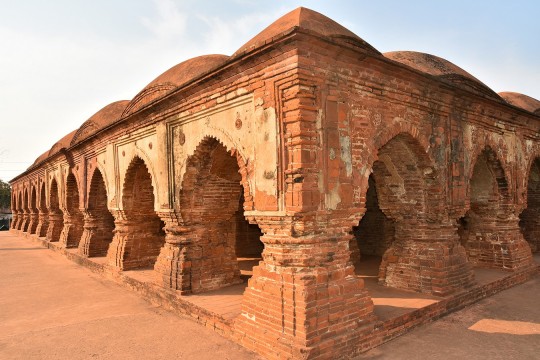
The Rasmancha is a heritage building located at Bishnupur, Bankura district, West Bengal.
Influence of the world on Bengal architecture: Although the Indo-Saracenic architectural style predominated in the area, Neo-Classical buildings from Europe were also present, particularly in or close to trading centers. While the majority of country estates had a stately country house, Calcutta, Dacca, Panam, and Chittagong all had extensive 19th and early 20th-century urban architecture that was equivalent to that of London, Sydney, or other British Empire towns. Calcutta experienced the onset of art deco in the 1930s. Indo-Saracenic architecture can be seen in Ahsan Manzil and Curzon Hall in Dhaka, Chittagong Court Building in Chittagong, and Hazarduari Palace in Murshidabad.
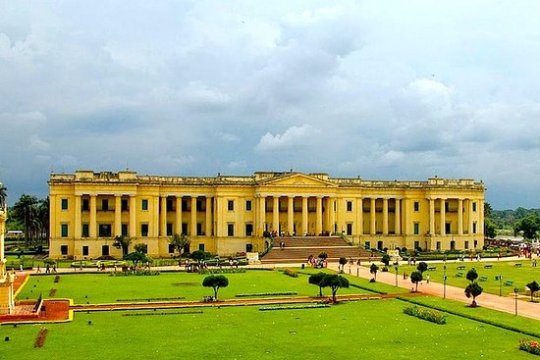
Hazarduari Palace in Murshidabad
The Victoria Memorial in Kolkata, designed by Vincent Esch also has Indo-Saracenic features, possibly inspired by the Taj Mahal. Additionally, Kolkata's bungalows, which are being demolished to make way for high-rise structures, have elements of art deco. The 1950s in Chittagong saw a continuation of Art Deco influences. The Bengali modernist movement, spearheaded by Muzharul Islam, was centered in East Pakistan. In the 1960s, many well-known international architects, such as Louis Kahn, Richard Neutra, Stanley Tigerman, Paul Rudolph, Robert Boughey, and Konstantinos Doxiadis, worked in the area.

The Jatiyo Sangshad Bhaban
This iconic piece of contemporary Bangladeshi architecture, was created by Louis Kahn. Midsized skyscrapers dominate the cityscapes of contemporary Bengali cities, which are frequently referred to as "concrete jungles." With well-known architects like Rafiq Azam, architecture services play a key role in the urban economies of the area. Overall Bengal architecture was influenced by various contemporaries of their time and continues to evolve.

Gothic architectural style seen in St. Paul's Cathedral in Kolkata.

Zamindar era buildings in ruin.

Belur Math in Howrah
#bengali#bangla#west bengal#bangladesh#tripura#assam#desi#বাংলা#india#architecture#tales#bengal architecture#history#kolkata#international#technology#information#temple#asia#bricks
189 notes
·
View notes
Text
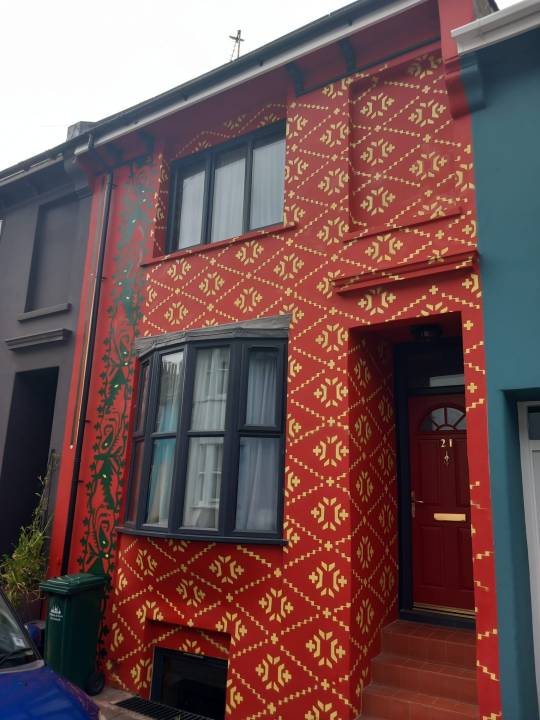
Brighton & Hove News, 28 July 2023:
'A Brighton family have literally stopped traffic with a new mural inspired by a sari pattern on their new home.
Poppy Jaman and Jaan Madan moved to Southampton Street in Hanover in January, and immediately knew they wanted to make a splash when decorating the outside.
She said: “One of the reasons we wanted to move to the centre of Brighton is that it’s so colourful.
“We were inspired by murals in Washington where there’s a whole area where there’s murals which have been created out of adversity.
“That inspired the idea of making a statement with our home. I wanted to not just paint something that I love. If you just love something that’s enough, but I also wanted to say here’s a bit of my identity.
“I collect saris and Jamdani is a signature saris of Bangladesh. It’s got a colonial past to it.

📷 X
The mural is inspired by the Jamdani weave saree, the signature saree of Dhaka, Bangladesh, which dates back at least as far back as 300BC.
Between the 16th and 19th centuries, Jamdani fabric – so fine it was known as ‘woven air’ – was one of the most highly coveted commodities in Mughal courts and further afield. However, by the mid-19th century, Jamdani had become almost extinct.
Poppy has written more about her relationship with the Jamdani design and its colonial history here.'
#sari#mural#brighton#mughal#textiles#textile history#jamdani#dhaka#bangladesh#colonial history#indian history#weave#woven fabric#pattern#surface pattern#surface pattern design#pattern design#textile design#surface decoration#street art#uk#england#british asian#saree#traditional crafts#traditional textiles#traditional clothing#bengali#weaving
139 notes
·
View notes
Text
When the Genocide in Bangladesh began, Pakistan martyred our intellectuals, writers, and poets first. There is another layer of heaviness that is felt when the world loses the folks whose work is meant to live long after they pass. But to see their time cut short is devastating.
75 notes
·
View notes
Text
Now.
Let’s make something quite clear.
Just for anyone who hasn’t gotten the message.
No.
You CANNOT compare the deliberate genocide and mass displacement of a people and destruction of their nation and identity to a natural process of change!
Nor is it alike to a culling of the weak through natural selection or evolution or anything like that.
And it certainly isn’t comparable to the changing of seasons or the clearance of old forests or whatever else they may say.
Nor is it akin to a cleansing or redeeming of the land or environment on which it takes place!
Ethnic “cleansing” is nothing of the kind.
It’s barbaric.
(BuT tHEy mAdE tHe DEseRt bLoOm¡)
Get in the bin with that reactionary SHITE!
It is in no way defensible or justifiable.
It is not REMOTELY natural!
Nor is it in any way inevitable!
And it sure as shit isn’t necessary either!
In ANY circumstance!
Anyone who denies this (and/or the occurrence of such atrocities) or tries to handwave or defend it is lying to you, and they KNOW they’re lying.
And there is no other defence for such atrocities outside of this thinking either.
Nobody “deserves” to be subject to a genocide. Whether real or hypothetically.
Whether it’s one that’s actively happening or one that has already happened.
Not now, not then, not ever.
Anyone who tells you otherwise is at best dangerously misinformed, perhaps also lying to you and at worst is already guilty!
Be rid of that shite!
Starting yesterday!
If you can’t or won’t do that, then the only thing you can do is die in ignorance and stupidity. And you will be met with ridicule by your descendants for it.
The same is true for denying that such genocides and atrocities ever happened’
There is NO defence for that shite either!
All that does is bury established history and indisputable facts and provide justification for further tyranny in turn!
Which is also wrong! But that should go without saying!
End this shit! Be better!
Starting yesterday!
I’ll include a few links to articles elaborating on this for clarity.
Also feel free to donate to Operation Broken Silence to help the people in Sudan.
Feel free to reblog this.
#dougie rambles#personal stuff#vent post#political crap#fucking hell#leftism#anti fascism#anti imperialism#anti genocide#anti revisionism#anti denialism#genocide#denialism#genocide denial#indefensible#shit takes#bad history#Holocaust#armenian genocide#anfal genocide#sayfo#bosnian genocide#yazidi genocide#rohingya#ethnic cleansing#rwandan genocide#East Timor genocide#Bangladesh genocide#enough of this shit#reblog the shit out of this
29 notes
·
View notes
Text
Since pride month is near the end I wanted to say some things to my queer siblings. This is important so please pay attention:
Write and draw YOUR own goddamn story. Corporations only care about profits so they are never gonna give us the proper representation that we deserve and straight people have their own fucking struggles, they don’t have time for us. You can do it professionally or as a hobby but please do it if you have the gift.
Read more books based on leftist theories. It will help you understand why the world is fucked up and how we can fix it.
Join left-wing political groups or parties. Despite what you have been told politics is life. Do you really want others to decide important things for you? Be political.
Donate to left-wing organizations, and join and support your local protest.
Learn to outlive your enemies. Just living a happy life and helping others to better theirs is a revolution, never forget that.
Know that if someone is intolerant to some groups they are also intolerant to others and obviously not your friends.
Remember that you might lose some of your so-called friends when you are trying to be your best and authentic self but you are gonna gain more true friends who will give up their lives to save yours.
We need to show the world that we are not what the reactionaries made us to be. We need visibility and it's our greatest weapon against bigotry, discrimination, and harassment.
Hiding isn’t gonna solve our problem. Running away from fascists is the same as being dead. Stand and fight as much as you can. Happy pride from Bangladesh.
By the way, if you ever come to Bangladesh please meet with me, I would love to host you.
#lgbtqia#lgbtq community#lgbt pride#lesbian#lgbtq#nonbinary#queer#sapphic#nonbinary lesbian#gay girls#bangladesh#dhaka#dhakacity#dhaka university#lgbt#lgbtqa#lgbtq positivity#lgbtq rp#pride#lgbt history#queer community#queer culture#queer characters#queer ns/fw#queer feedee#queerplatonic#queer poetry#coming out#pride month#pride headcanons
79 notes
·
View notes
Text

Rest in piss! Finally!
#politics#us politics#history#war#henry kissinger#kissinger#war criminal#mass murder#vietnam war#vietnam#cambodia#nixon#richard nixon#chile#pinochet#augusto pinochet#argentina#bangladesh#pakistan#laos#war crimes#injustice#progressive#foreign policy#operation condor#rest in piss#RIP
25 notes
·
View notes
Text
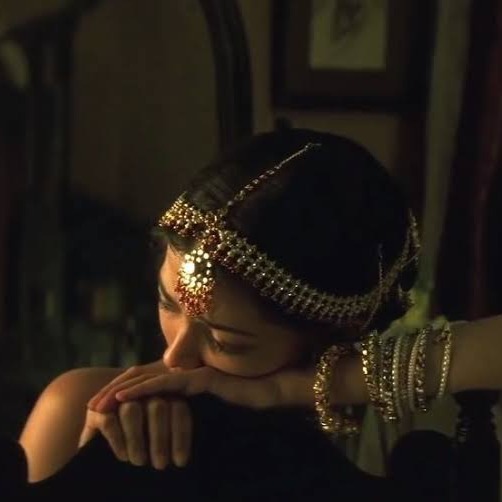
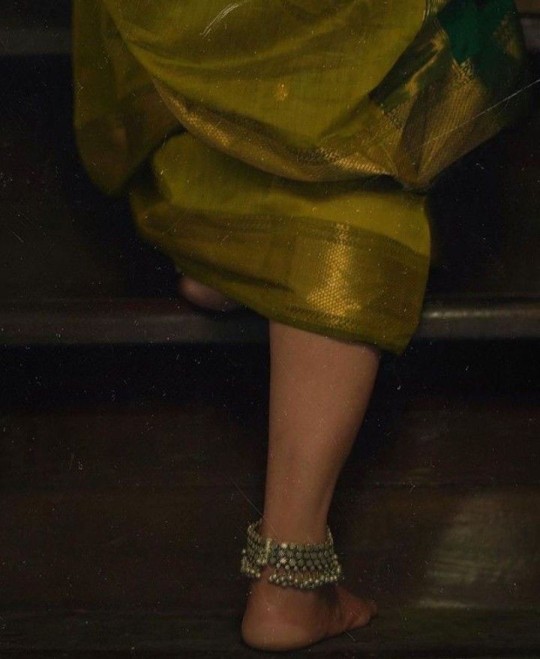
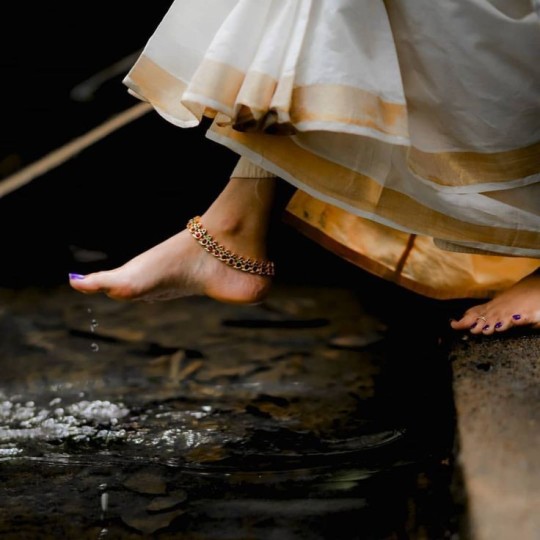
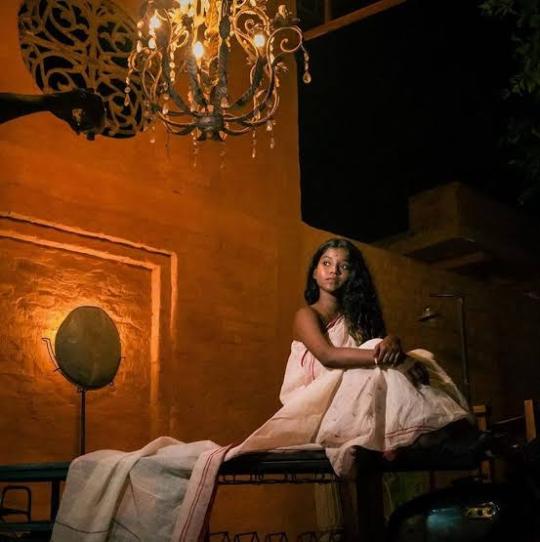

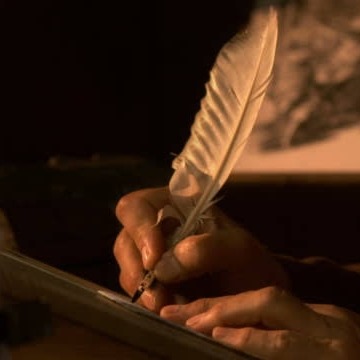

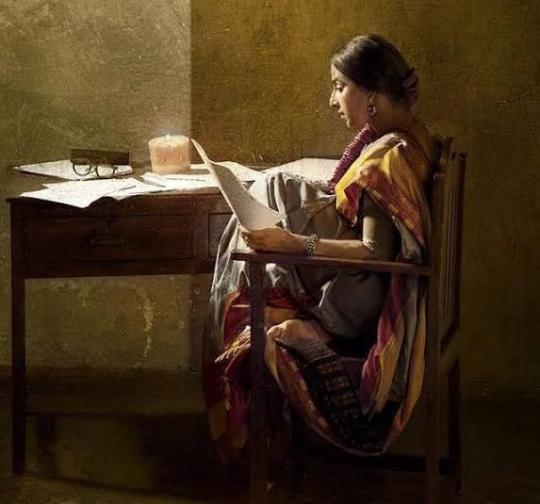
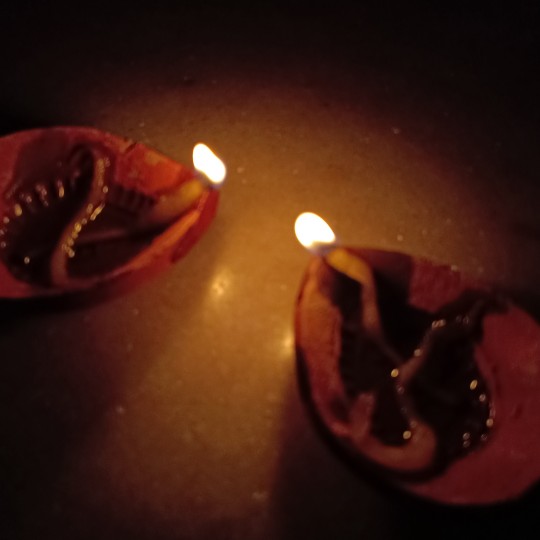
Khona was a poet and astronomer from Deulia village in Bengal, best known for Khonar Bochon, a series of couplets and short rhymes which imparts advice regarding agricultural and rural life. Born somewhere between 800-1200 A.D., Khona defied social and cultural norms of her time when women were rarely taught to read. Her husband Mihir was the son of the philosopher and astronomer Barahmihir, who was one of the navaratnas (nine gems) at the court of Chandragupta II. Khona lived in Chandragupta's court in Pataliputra for a time with her husband and father-in-law. According to legend, Chandragupta was so impressed with Khonar Bochon which benefited the farmers of his state that he named Khona the tenth gem of his court. Khonar Bochon remains relevant to the agricultural life of rural Bengal to the present day.
ষোল চাষে মূলা / তার অর্ধেক তুলা / তার অর্ধেক ধান / বিনা চাষে পান।
Translation: After 16 days of cultivation, radish cultivation in that land gives good yield. Cotton land requires 8 days of cultivation, paddy land after 4 days of cultivation gives good yield. Betel does not require cultivation.
1 / 2 / 3 / 4 / 5 / 6 / 7 / 8 / 9
#mb#khona#khonar bochon#khana#bengali academia#bangla tag#bangladesh#india#desi academia#dark academia#desi aesthetic#desi tag#desi tumblr#desiblr#bengali#indian history#ancient india#khonar bochor for anon#bengali literature
407 notes
·
View notes
Text
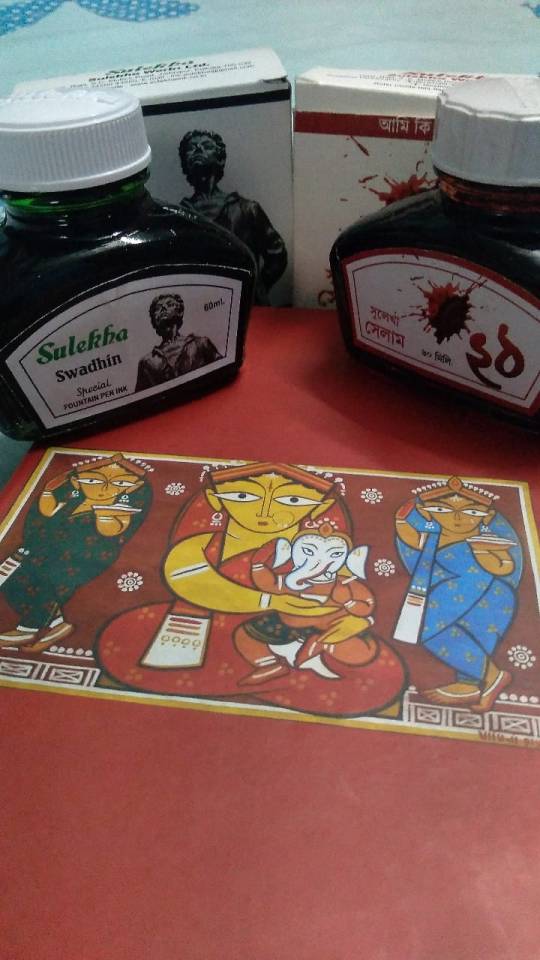
এক ফালি ইতিহাস
A Slice of History
So my father went to the Kolkata International Bookfair or any Bangali's favourite Boimela. He saw a stall of Sulekha inks...The Sulekha inks and of course he had to explore.
Let me share with you a brief history of Sulekha....
Around 1932 Satish Das Gupta, an ex-chemist of Bengal Chemicals prepares Swadeshi ink, names it Krishnadhara and sells it through Khadi outlets. He then hands the recipe over to Maitra brothers Shankaracharya and Nani Gopal and asked them to make the ink commercially and call it Sulekha ( there is also a story which claims Kobiguru Rabindranath Thakur gave them the name সুলেখা or Sulekha ). After years of an illustrious journey they closed around 1990 and then reopened in 2006.
So my father purchased three things. Two inks and a notebook.
The first ink is a blood red ink called সেলাম ( Selaam or Salaam ). It was made as a gift to Bangladesh commemorating The Language Movement ( ভাষা আন্দোলন ). At first 21 bottles were gifted as a tribute to 21st February. And the creator of the ink mixed in a drop of his blood in the first 21 bottles. Then the ink became popular and was manufactured more. It is a beautiful red colour...and every drop of this ink holds in it the memories of every drop of blood shed for my beloved Bangla Bhasha.
The second ink is a vibrant green. Coloured just like the green of India's Tiranga. This ink was formulated on the day after India's Independence. It is called Swadhin or স্বাধীন.
The third is a notebook made in collaboration with jamini Ray's family. And I absolutely love that notebook.
#history#indian history#spilled ink#miru writes#kolkata#bengblr#desiblr#india#bangladesh#bangla tag#bangla#language#inks#international language day#bhasha dibosh
98 notes
·
View notes
Text

Kabir is God
Holy Yajurved Adhyay 29 Mantra 25
One, who brings and imparts the true bhakti of the Supreme God in the form of a messenger is Himself KavirDev i.e. Supreme God Kabir.
#santrampaljimaharaj#godkabir#history#tumblr history#hindu#hinduism#india#photography#bhutan#thimphu#dhaka#chennai#colombo#sri lanka#bangladesh#australia
7 notes
·
View notes